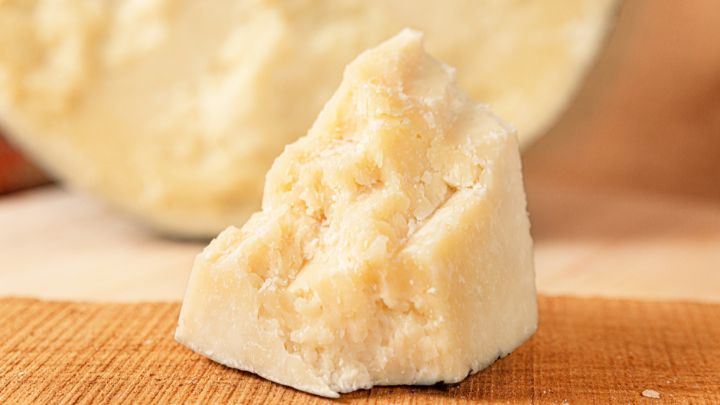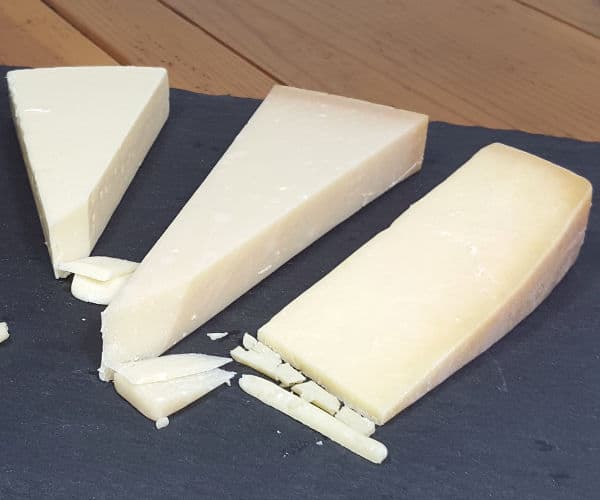Introduction

The world of cheese offers a wide variety of flavors and textures to tantalize our taste buds. Two popular choices in the Italian cheese category are Asiago and Parmesan. Both cheeses have a rich history and distinctive characteristics that make them stand out. In this cheese showdown, we will explore the origins, aging processes, flavor profiles, and uses of Asiago cheese and Parmesan. By delving into the differences and similarities between these two cheeses, we hope to guide you in making an informed choice for your next culinary creation. So let the battle between Asiago cheese and Parmesan commence!
Overview Of Asiago Cheese And Parmesan
Asiago Cheese and Parmesan are both popular Italian cheeses known worldwide for their delicious flavors and versatile uses in various culinary creations.
Asiago Cheese, hailing from the Asiago plateau in Northern Italy, is a semi-hard cheese with a buttery and nutty taste. It is available in different ages, ranging from fresher and milder Asiago Pressato to the more aged and sharper Asiago Stravecchio.
Parmesan, also known as Parmigiano-Reggiano, is a hard and granular cheese from the Parma and Reggio Emilia regions in Italy. It has a rich and robust flavor, with fruity and savory notes and a distinct earthiness.
These cheeses are widely used in Italian cuisine, adding depth and complexity to dishes like pasta, risotto, salads, and more.
History And Origin Of Asiago Cheese And Parmesan
Asiago Cheese has a long history that dates back to the 10th century in the Asiago plateau region of Italy. It was traditionally made by local farmers to preserve surplus milk during the summer months. Over time, Asiago Cheese gained popularity and became an important part of the region’s culinary heritage.
Parmesan, known as Parmigiano-Reggiano in Italian, has an even richer history. It can be traced back to the Middle Ages in the Parma and Reggio Emilia regions of Italy. Parmesan was originally made by monks using a precise and labor-intensive process. Today, it is still produced with the same traditional methods and is protected by strict regulations to ensure its authenticity and quality.
Asiago Cheese

Asiago Cheese is a traditional Italian cheese with a rich history and unique flavor. Made from cow’s milk, it is known for its slightly buttery, creamy, and nutty taste. It also has a distinct bitterness, especially in the aged variety, Asiago Stravecchio. With its smooth texture and creamy consistency, Asiago Cheese is versatile and can be enjoyed in various dishes. Whether grated over pasta, melted in sandwiches, or used in salads, Asiago Cheese adds depth and richness to your culinary creations. Its flavor profile, combined with its centuries-old tradition, makes Asiago Cheese a beloved choice for cheese enthusiasts.
Characteristics And Flavor Profile Of Asiago Cheese
Asiago Cheese is known for its distinct characteristics and unique flavor profile. It has a smooth texture and creamy consistency, making it great for melting and grating. Asiago Cheese is slightly buttery, creamy, and nutty in taste, with a hint of bitterness in the aged variety. Its flavor is well-balanced and can complement a variety of dishes. Whether used in pasta, salads, or sandwiches, Asiago Cheese adds depth and richness to any recipe. Its versatile flavor and creamy texture make it a popular choice for cheese enthusiasts.
Types And Aging Process Of Asiago Cheese
Asiago Cheese comes in different types, each with its own distinct characteristics. The two main types are Asiago Pressato and Asiago d’allevo.
- Asiago Pressato: This type is aged for a short period of time, typically ranging from 20 to 40 days. It has a semi-soft texture and a mild, creamy flavor, making it perfect for snacking or melting.
- Asiago d’allevo: This type is aged for a longer period of time, usually between 3 months to 2 years. It has a firmer texture and a more pronounced, nutty flavor. Aged Asiago d’allevo is often grated over pasta dishes or used in salads for added depth and richness.
The aging process allows the cheese to develop its flavor and texture, resulting in a range of options for different culinary applications.
Parmesan

Parmesan cheese is known for its sharp and robust flavor, making it a popular choice in Italian cuisine. It has a distinctive earthy undertone and well-expressed fruity and savory notes. Parmesan is aged for a minimum of 12 months, resulting in a hard and crumbly texture. The aging process brings out the rich flavors and creates a grainy texture that melts in your mouth. Grated Parmesan is commonly sprinkled over pasta, risottos, and soups, adding a delightful depth of flavor. Its intense flavor also pairs well with bold ingredients like garlic, tomatoes, and herbs.
Characteristics And Flavor Profile Of Parmesan
Parmesan cheese is known for its sharp and robust flavor, making it a popular choice in Italian cuisine. It has a distinctive earthy undertone and well-expressed fruity and savory notes. Parmesan is aged for a minimum of 12 months, resulting in a hard and crumbly texture. The aging process brings out the rich flavors and creates a grainy texture that melts in your mouth. Grated Parmesan is commonly sprinkled over pasta, risottos, and soups, adding a delightful depth of flavor. Its intense flavor also pairs well with bold ingredients like garlic, tomatoes, and herbs.
Types And Aging Process Of Parmesan
Parmesan cheese is typically divided into two types based on the aging process: “Parmigiano Reggiano” and “Grana Padano.”
Parmigiano Reggiano is the more prestigious and traditional variety, produced in the specific regions of Parma, Reggio Emilia, Modena, Bologna, and Mantua in Italy. It is aged for a minimum of 12 months, but many wheels are aged for 24 months or longer. The longer aging period gives Parmigiano Reggiano a complex and intense flavor with a deep, nutty profile.
Grana Padano, on the other hand, is slightly less aged, typically ranging from 9 to 16 months. It is produced in a broader area of Northern Italy. While similar in taste and texture to Parmigiano Reggiano, Grana Padano is often considered to be milder and creamier.
Both types of Parmesan undergo a natural aging process, allowing the cheese to develop its characteristic flavors and textures. The aging process also contributes to the hard and granular texture of Parmesan, making it ideal for grating over pasta or salads.
Differences Between Asiago Cheese And Parmesan

When it comes to comparing Asiago Cheese and Parmesan, there are several notable differences in their characteristics and flavors.
- Texture, taste, and aroma differences: Asiago cheese is slightly more buttery, creamy, and nutty compared to Parmesan. It also has a more well-pronounced and noticeable bitterness, especially in aged Asiago Stravecchio. On the other hand, Parmesan tends to be sharper and more robust, with well-expressed fruity and savory notes, as well as a distinct earthiness.
- Uses and recipes: While both cheeses are excellent for grating over pasta or salads, Asiago cheese is often used in dishes like risotto or melted on top of pizzas. Parmesan, on the other hand, is a popular choice for enhancing the flavors of Italian dishes such as pasta, soups, and sauces.
These differences in taste and usage make Asiago Cheese and Parmesan distinct choices for different culinary experiences.
Texture, Taste, And Aroma Differences
When comparing Asiago Cheese and Parmesan, there are notable differences in their texture, taste, and aroma. Asiago cheese has a slightly more buttery, creamy, and nutty texture, while Parmesan tends to be sharper and more robust. In terms of taste, Asiago has a well-pronounced bitterness, especially in aged varieties like Asiago Stravecchio. Parmesan, on the other hand, has well-expressed fruity and savory notes, along with a distinct earthiness. These flavor profiles contribute to the overall aroma of each cheese, making Asiago and Parmesan distinct in their characteristics.
Uses And Recipes For Each Cheese
Asiago Cheese and Parmesan have their own unique uses and are commonly incorporated into various recipes.
Asiago Cheese is commonly used in Italian cooking and is often grated over pasta dishes or added to risottos and soups for added flavor. It can also be melted and used as a topping for pizzas, or sliced and enjoyed on a cheese platter. For a simple snack, Asiago can be paired with fruits and nuts.
Parmesan, on the other hand, is widely used as a grated cheese for pasta dishes, such as spaghetti or lasagna. It is also a key ingredient in classic recipes like Caesar salad dressing and pesto sauce. Parmesan can be enjoyed on its own, paired with fruits or cured meats, or used to enhance the flavor of roasted vegetables.
Overall, both cheeses can elevate the taste of various dishes and add a rich, savory element to your meals.
Similarities Between Asiago Cheese And Parmesan

Asiago Cheese and Parmesan share some similarities despite their unique characteristics. Here are a few common features of these two cheeses:
- Hard Italian Cheeses: Both Asiago and Parmesan belong to the family of hard Italian cheeses, which means they are aged and have a dense texture.
- Nutritional Profile: Both cheeses are rich in calcium and protein, making them a good source of nutrients.
- Versatile Uses: Asiago and Parmesan can be grated over pasta dishes, used as a topping for pizzas, or enjoyed on a cheese platter. They can also be paired with fruits, nuts, or cured meats.
- Flavor Enhancers: Due to their strong, savory flavors, both cheeses can add depth and richness to various recipes, enhancing the overall taste of dishes.
In conclusion, while Asiago Cheese and Parmesan have their own distinct characteristics, they also share some commonalities in terms of their uses, nutritional content, and flavor-enhancement abilities.
Nutritional Profile And Health Benefits
Both Asiago Cheese and Parmesan offer a range of nutritional benefits. These cheeses are high in calcium and protein, making them an excellent choice for bone health and muscle development. Additionally, they are low in fat, making them a healthier option compared to other types of cheese. Both cheeses also contain essential vitamins and minerals, including vitamin A, vitamin B12, and zinc. Incorporating Asiago Cheese or Parmesan into your diet can contribute to a well-balanced and nutritious eating plan. However, moderation is key due to their naturally high sodium content.
Pairings And Serving Suggestions
Asiago Cheese and Parmesan are both versatile cheeses that can be enjoyed in a variety of ways. Here are some pairings and serving suggestions for each cheese:
- Asiago Cheese:
- Pair with fruits such as apples, pears, or figs for a sweet and savory combination.
- Use in pasta dishes, risottos, or salads for added richness and flavor.
- Serve alongside cured meats and olives for a delicious cheese board.
- Grate over soups or roasted vegetables for a burst of flavor.
- Enjoy with a glass of red wine or a light beer.
- Parmesan:
- Sprinkle over pasta dishes, pizzas, or salads for a delightful cheesy finish.
- Pair with balsamic vinegar or honey for a sweet and tangy contrast.
- Serve with crusty bread and drizzle with olive oil for a simple and satisfying appetizer.
- Use as a topping for creamy soups or roasted vegetables for added depth of flavor.
- Enjoy with a glass of full-bodied red wine or a crisp white wine.
Both cheeses can also be enjoyed on their own as a delightful snack. Experiment with different pairings to find your favorite combinations.
Conclusion

In conclusion, both Asiago Cheese and Parmesan are exceptional cheeses that have distinct characteristics and are widely used in Italian cuisine. Asiago Cheese is known for its mild and creamy flavor, while Parmesan has a sharper and more granular texture. Each cheese brings its own unique taste and texture to various dishes, making them versatile ingredients in the kitchen. Whether you’re looking for a milder and creamier cheese or a sharper and more intense flavor, both Asiago Cheese and Parmesan are sure to elevate your culinary creations.
Final Thoughts On Asiago Cheese Vs Parmesan
Asiago Cheese and Parmesan are both outstanding cheeses with their unique characteristics and flavors. While Asiago Cheese offers a mild and creamy taste, Parmesan brings boldness and sharpness to the table. The choice between the two ultimately comes down to personal preference and the specific dish being prepared. Whether you prefer the buttery notes of Asiago or the robust flavors of Parmesan, both cheeses add depth and richness to any recipe. So, whether you’re making pasta, risotto, or a cheeseboard, both Asiago Cheese and Parmesan are sure to impress.
Personal Preferences And Recommendations
When it comes to personal preferences, some individuals may lean towards the milder and creamier nature of Asiago Cheese, while others may prefer the bold and sharp flavors of Parmesan. It ultimately boils down to individual taste and the specific dish being prepared. For those seeking a versatile option that can be used in a variety of dishes, Parmesan is an excellent choice. On the other hand, if you’re looking for a cheese that adds a delicate touch to salads or lighter recipes, Asiago Cheese is the way to go. Whichever you choose, both Parmesan and Asiago Cheese are sure to enhance the flavor of your favorite dishes.
Frequently Asked Questions
Q: What is the difference between Asiago cheese and Parmesan cheese?
A: Asiago cheese and Parmesan cheese are both popular Italian cheeses, but they have distinct characteristics that set them apart.
Q: Where do Asiago and Parmesan cheeses originate from?
A: Asiago cheese comes from the northeastern region of Italy, primarily the Veneto and Trentino regions. Parmesan cheese, also known as Parmigiano-Reggiano, is produced in specific areas of northern Italy, including Parma, Reggio Emilia, Modena, Bologna, and Mantua.
Q: How are Asiago cheese and Parmesan cheese made?
A: Both cheeses are made from cow’s milk but have different processes. Asiago cheese is traditionally made from raw or partially skimmed milk, while Parmesan cheese is made from skimmed milk. Parmesan cheese undergoes a longer aging process, typically around 24 months, which contributes to its distinct flavor.
Q: What are the flavor profiles of Asiago and Parmesan cheeses?
A: Asiago cheese has a smooth texture and a sweet, nutty flavor when it is young. As it ages, the flavor intensifies and becomes sharper. Parmesan cheese has a hard, granular texture and a rich, savory, and slightly fruity taste. It develops a distinct and complex flavor as it matures.
Q: Are Asiago cheese and Parmesan cheese interchangeable in recipes?
A: While both cheeses are delicious and can be used in various dishes, they have different flavors and textures. Asiago cheese works well as a table cheese and in pasta dishes, while Parmesan cheese is widely used in Italian cooking, including grating over pasta, risottos, soups, and salads. It is also commonly used as a sprinkling cheese due to its strong flavor.
Q: What is the best way to store Asiago and Parmesan cheeses?
A: To maintain their freshness and flavor, both cheeses should be stored in the refrigerator. Wrap the cheeses in wax or parchment paper and place them in airtight containers or resealable plastic bags. Make sure to remove any excessive air to prevent moisture from reaching the cheese.
Q: Can Asiago and Parmesan cheeses be frozen?
A: Yes, both Asiago and Parmesan cheeses can be frozen. It is best to grate or slice the cheeses before freezing. However, freezing can alter the texture of the cheeses slightly, so they may not be ideal for certain dishes where texture is important. Allow the cheese to thaw slowly in the refrigerator before using it.
Q: Are Asiago and Parmesan cheeses suitable for individuals with lactose intolerance?
A: While both cheeses are made from cow’s milk, they are aged for an extended period, which significantly reduces the lactose content. As a result, many individuals with lactose intolerance can tolerate small amounts of Asiago and Parmesan cheeses. However, it is best to consult with a healthcare professional if you have specific dietary concerns.
Q: What are some popular dishes that feature Asiago and Parmesan cheeses?
A: Asiago cheese can be enjoyed on its own or used in various recipes, such as pasta salads, soufflés, and baked dishes. Parmesan cheese is commonly grated over pasta dishes like spaghetti bolognese or used as a topping on pizza, risotto, or Caesar salads. Both cheeses are versatile and can add a delightful flavor to many meals.

From At-Home Dinner Parties to Family Reunions to Office Parties, we can cater your next Event!